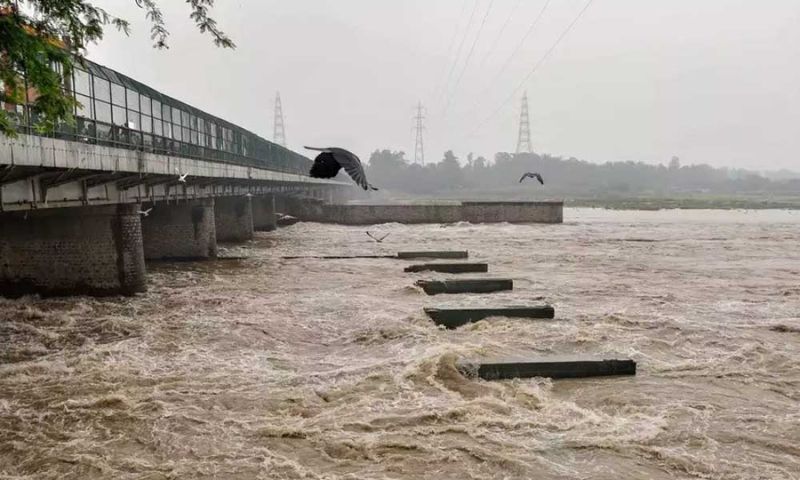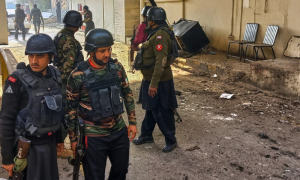Key points
- Pakistan slams India for violating Indus Waters Treaty in flood warnings
- Under Indus Waters Treaty, warnings are required to pass through Permanent Indus Water Commission
- Pakistan says India’s unilateral actions undermine the waters treaty’s mechanism and warns of their potential impact on regional peace and stability.
ISLAMABAD: India has informed Pakistan of possible flooding in the Tawi River, but the warning was relayed through diplomatic channels instead of the Indus Waters Treaty mechanism.
According to reports, the Indian High Commission in Islamabad on the morning of Sunday, August 24, communicated a flood warning to Pakistan’s Foreign Office concerning the Tawi River, a tributary of the Chenab.
Pakistan on Monday slammed India for violating the Indus Waters Treaty (IWT) while communicating flood warnings through diplomatic channels instead of the Indus Waters Commission, saying the move was a “serious violation of international law.”
Pakistan’s Foreign Office Spokesperson Shafqat Ali Khan said that India’s unilateral actions undermine the waters treaty’s mechanism and warned of their potential impact on regional peace and stability.
“We reaffirm that India is obligated to fully comply with all provisions of the Treaty. India’s unilateral declaration to hold the Treaty in abeyance constitutes a serious violation of international law and could have significant negative consequences for peace and stability in South Asia”, the spokesperson said.
Under the 1960 Indus Waters Treaty (IWT), all such warnings are required to pass through the Permanent Indus Water Commission. By bypassing the commission, India has effectively reinforced that the treaty remains suspended in practice, despite the fact that there is no legal clause allowing one party to unilaterally abbey it.
Technical limits of Tawi flows
Water management expert Dr Hassan Abbas told this correspondent that the gesture was overstated.
“The maximum flow capacity of the Tawi River is no more than 60,000 cusecs, while the Head Marala Barrage is designed for 800,000 cusecs. Hydrologically, this warning changes nothing. It is eyewash intended to project goodwill at little cost,” Dr Abbas said.
He added that Pakistan must also highlight at international fora — particularly before the World Bank, the broker of the IWT — India’s practice of dumping untreated drains into the rivers that flow downstream, chiefly the Ravi and Sutlej.
“This environmental violation impacts water quality and agriculture in Pakistan. Our case must be pressed at the World Bank and other global forums to expose India’s misuse,” he urged.
Satellite capability makes warning redundant
Pakistan’s own remote-sensing satellite systems have given it the ability to monitor environmental activity and river flows in real time. Experts say that India’s effort to play the “compassionate” neighbour by issuing a manual warning loses relevance when Pakistan already has direct surveillance over such movements.
Kashmir dispute at the core
The development comes four months after the two countries clashed in the May 2025 military exchange, triggered by the Pahalgam false-flag operation in Indian Illegally Occupied Jammu & Kashmir (IIOJK), which New Delhi blamed on Pakistan without credible evidence.
The incident further strained relations already soured by India’s unilateral suspension of the IWT in April. The suspension followed decades of conflict, including four wars fought between Pakistan and India, each rooted in the unresolved Kashmir dispute.
Humanitarian gesture or tactical signalling?
Diplomatic observers believe India’s alert is designed less as a humanitarian move and more as tactical signaling to portray itself as a responsible regional actor.
“It is no coincidence that this was pushed through the media, particular channels, and newspapers. The attempt is to shape international optics rather than meaningfully revive treaty cooperation,” a senior diplomatic source said on condition of anonymity.
History of sudden releases
This is not the first time India’s river releases have raised concerns. Over the years, sudden water discharges into the Chenab and Sutlej have repeatedly flooded villages in Pakistan’s Punjab, damaging crops and infrastructure. Pakistani officials maintain that such moves are often timed politically, underscoring why the IWT remains crucial.
At Head Marala, located near Sialkot, the confluence of the Tawi and Chenab has historically been managed to withstand major surges. Local engineers note that the barrage’s design capacity leaves ample buffer against smaller tributary inflows such as those from the Tawi.
Legal debate over treaty suspension
Dr Abbas described the current situation as “tricky,” pointing out that the IWT cannot legally be suspended by one party.
“There is no clause for unilateral suspension in the treaty. India’s April decision was political, not legal. Pakistan should stop begging for restoration and instead weigh whether renegotiation—or even moving beyond the treaty—is the wiser course,” he argued.
International law experts agree that unless both Pakistan and India agree to amend or annul it, the treaty technically remains in force. India’s selective engagement — suspending routine data sharing while issuing occasional alerts — underscores the grey area that has emerged.
Bigger picture: mistrust and climate stress
The Tawi episode has once again exposed the fragility of water diplomacy between two nuclear-armed neighbours. Climate change is intensifying monsoon variability and glacier melt, increasing the need for data-sharing and coordination. Yet as experts point out, bilateral relations are not shaped by nature or climate, but by hard national interests and the unresolved status of IIOJK.
For Pakistan, the key challenge lies in combining legal arguments at international platforms, technical preparedness at barrages like Marala, and diplomatic firmness in countering India’s narrative.
Third eye view
While India’s flood alert may appear as a thaw, experts and officials caution against reading too much into the gesture. With the Pahalgam false-flag episode fresh in memory, four past wars fought, and the IWT in limbo, mistrust remains the defining feature of Pakistan-India relations. For now, the Tawi warning stands less as a bridge of cooperation and more as another reminder of the deep fissures that separate the two neighbours.


























